This was published 7 years ago
Cruise ship passengers break away from guided tours to see real life in Cuba
By Mike Clary
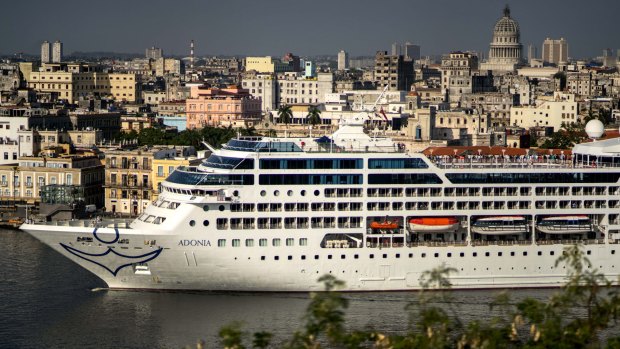
Carnival's Adonia cruise ship arrives from Miami in Havana, Cuba on May 2, 2016.Credit: Ramon Espinosa
While still basking in the glow of the enthusiastic welcome they received from hundreds of Cubans at the dock in Havana, some Adonia passengers began to wonder if two days of guided tours gave them an accurate picture of the harsh realities of everyday life on the communist-led island.
"I didn't feel any oppression at all. No military presence. But I did feel the guided tours were a little staged, as you would expect," said Indiana restaurateur Diana Twyman, one of more than 600 passengers on the maiden voyage of Carnival's Fathom brand of "social impact" travel. "There is so much desperation just below the surface."
That desperation is tied largely to economic hardship in a nation where even doctors may make no more than $35 a month. Since the relatively small but luxurious liner Adonia left Port of Miami on Sunday afternoon, at least 18 Cubans in small boats have made it to shore in the Florida Keys. More than 3500 Cubans have been spotted or interdicted at sea since October 1, according to the US Coast Guard.
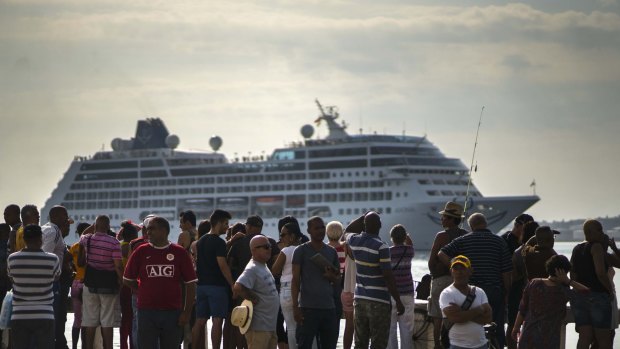
People watch Carnival's Adonia cruise ship arrive from Miami, in Havana, Cuba.Credit: Ramon Espinosa/AP
To get a peek into the sense of despair that drives many Cubans to risk their lives at sea, adventurous Adonia passengers had to break away from the tours.
They walked Old Havana streets where crumbling buildings are still inhabited, hired taxi drivers to take them to places well off the tourist paths, and fought through language barriers to learn how Cubans resolve problems with invention instead of money.
"We bailed out of a museum tour, found a taxi driver with a 1949 Ford and told him to take us to a local bar," Rick Meares, a businessman from Jupiter, Florida, said as he sat on Adonia's sun deck as the vessel headed for Cienfuegos, the next port on the weeklong cruise.
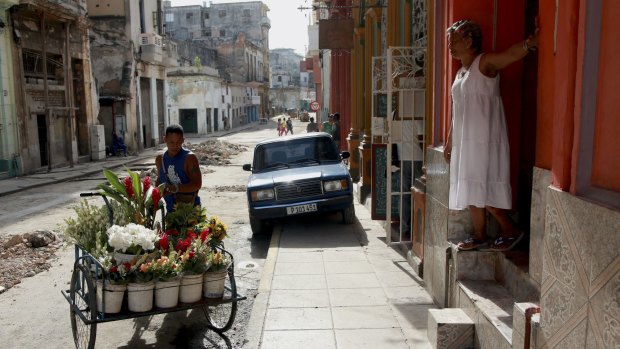
A flower salesman pushes his cart down a street in Havana, Cuba.Credit: Bloomberg
Even without fluent Spanish, Meares said, he and his wife Susan "got by and we learned a lot."
The model for Fathom's participatory travelling was previewed last month on a trip to the Dominican Republic, where passengers spent several days in one port volunteering to work on community projects such as planting trees.
The Cuba cruise is different. There are no cooperative service projects here. There were two days in Havana, and still to come is a six-hour stop Thursday in Cienfuegos and an eight-hour visit to Santiago de Cuba on Friday. The Adonia returns to Port of Miami on Sunday morning.
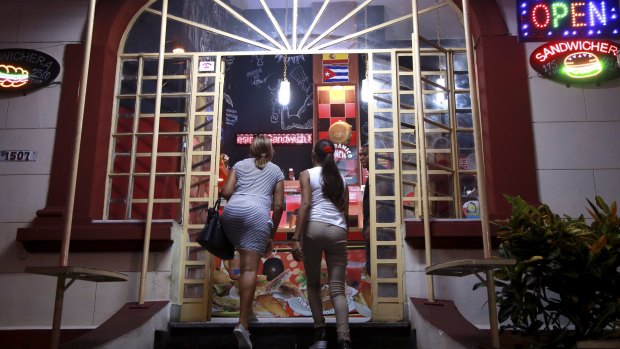
Two young women enter the Sandwichera sandwich shop in Havana, Cuba.Credit: Bloomberg
Fathom brand President Tara Russell acknowledged that the maiden voyage has exposed kinks that need to be smoothed out. Complaints that surfaced Monday about authoritarian tour guides - employed by the state-run Havanatur agency - and about poor planning on excursions to the Tropicana nightclub are being addressed, Russell said.
But ensuring that travellers can get an understanding of how most Cubans live will be a challenge, Carnival officials acknowledge. Travellers "hunger for travel that goes deep, and want to make a meaningful difference in the world," Russell said on the first day of the weeklong trip.
"We've been doing that in the Dominican Republic. In Cuba it's just beginning."
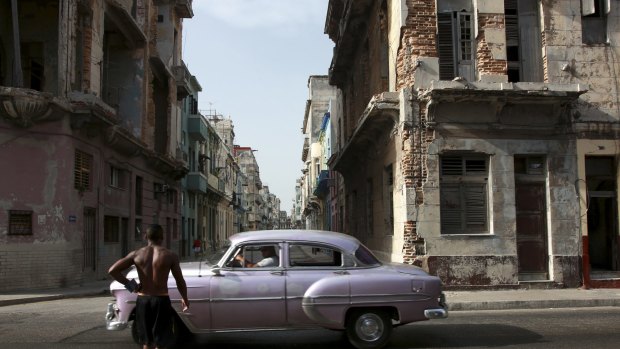
A car passes a pedestrian in the street in Havana, Cuba.Credit: Noah Friedman-Rudovsky
During tours, Adonia passengers reported that some guides seemed to go off script, giving candid answers to questions about incomes, education, health care and the dual currency system in which most people are paid in Cuban pesos, and not the dollar-equivalent money that tourists can spend.
But many travellers longed for more. "I wanted to go to a market where Cubans shop, or see a school," said Susan Meares.
Twyman said the economic desperation she sensed just below the surface in Cuba was brought home to her even before she began to explore Havana. As the Adonia pulled into the harbour Monday morning, she said she watched as a boy, about 10 years old and wearing a red shirt, raced along the Malecon, waving and shouting as he kept pace with the liner.
That sight, said Twyman, symbolised the pent up desire for change she felt in later talking to Cubans on the ground. "What this ship and other ships to come are doing is letting the genie out of the bottle," she said.
"That boy in the red shirt was excited, Twyman said. "Change is coming. And he knew his life was about to change too."
Sun Sentinel/MCT
See also: The cruise journey 50 years in the making
See also: The top places to visit by ship in 2016
Sign up for the Traveller Deals newsletter
Get exclusive travel deals delivered straight to your inbox. Sign up now.